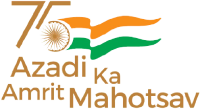Imager
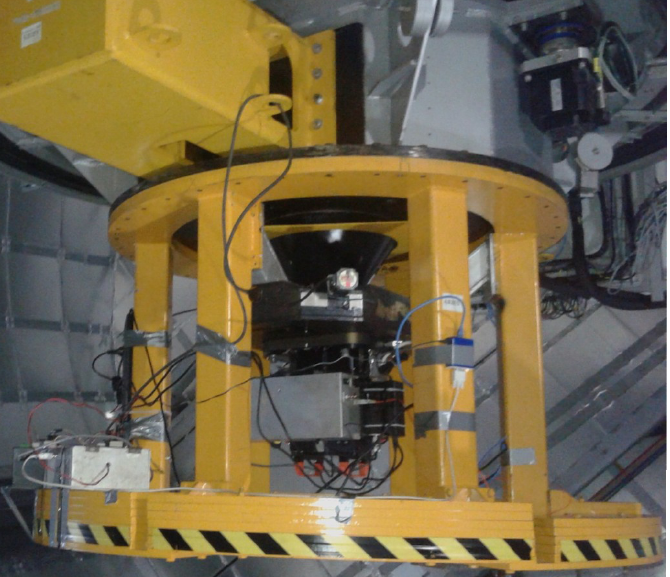
As an in-house developmental activity, the 4KX4K CCD Imager is designed and assembled as a first light instrument for the axial port of the 3.6m DOT using the f/9 beam directly for a plate scale of 6.4 arc-sec/mm. The pixel size of the blue enhanced liquid Nitrogen cooled STA4150 CCD chip is 15 micron with options to choose gain and speed to utilize the dynamic range. It is possible to acquire multi-band images of the central 6.5×6.5 arc-min of FoV of the telescope for variety of scientific goals getting a deeper photometry in several broad-band filters for point sources and objects with low-surface brightness. The median seeing of Devasthal site is 1.1 arc-sec and occasionally seeing as low as 0.7 arc-sec (~ 10% of the observing time) as seen during ground level seeing measurements.
Camera Specifications:
Port/f-ratio : Axial port / direct use of the f/9 beam
CCD Chip : 15 micron/pixel, 4096×4096 pixels, back- illuminated, 16-bit A-D
Full-well capacity : 250k — 265k electrons, MPP/non-MPP modes
Gain : 1,2,3,5,10 electrons/ADU (selectable)
Read-out Noise (speed) : 7-9 electrons (@1 MHz) or 4-6 electrons (@500 KHz) or 2-3 electrons (@100 KHz)
Binning : 2×2, 3×3 or 4×4, selectable as per the requirement
Dark Current : 0.0005 electrons at -120 C
Dewar, Operating Temp : Liquid Nitrogen based, -121.3 C
For this CCD camera, images could be saved in .FITS format with an option to save bias and dark levels of each frame individually by adding certain number of over-scan pixels both in lines and columns. It is also possible to read-out the chip in a single more using only one amplifier or one could choose a ”quad” mode reading all the four quadrants separately. However, while opting for a ”quad” mode for some of the science cases, one should be careful about the pre-processing of the .FITS files before further processing/calibrations.
Shutter and Filters:
The camera has software controlled (ARCHON controller, OFC-based) mechanism to open and close 125mm Bonn shutter (shortest exposure of 10 msec) along with an automated motorized filter wheel movement for two sets of wheels. Each wheel contains 5 sets of Bessel or SDSS filters with one clear space to select one filter at a time. From one filter to the next one, minimum time taken is 15 sec.
Presently, with this instrument, CCD imaging could be done in following sets of 10 broad-band filters.
Filters Central wavelength/Band-width Filters Central Wavelength/Band-width
(Set 1) (Angstrom units) (Set 2) (Angstrom units)
Bessel U 3663 / 650 SDSS u 3596 / 570
Bessel B 4361 / 890 SDSS g 4639 / 1280
Bessel V 5448 / 840 SDSS r 6122 / 1150
Bessel R 6407 / 1580 SDSS i 7439 / 1230
Bessel I 7980 / 1540 SDSS z 8896 / 1070
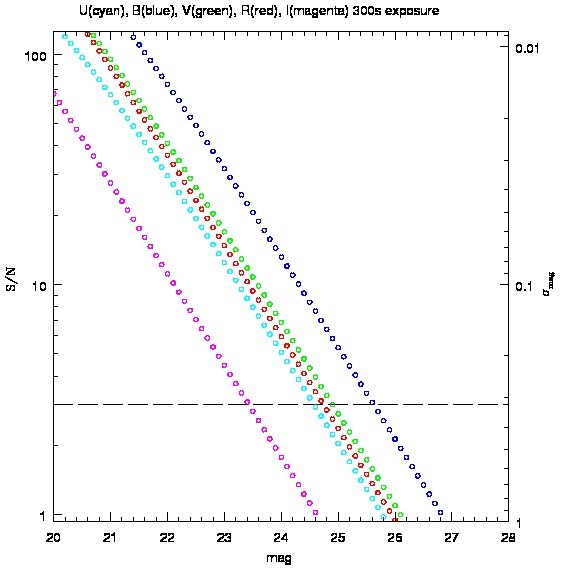 |
Simulations & Calibrations Throughput of the CCD Imager was calculated using the above parameters, the standard specifications of the 3.6m DOT and using the published values of the extinction coefficients, sky-brightness for an assumed value of 1 arc-sec FWHM at zenith. In the figure below, simulated results of the signal to noise ratio at different brightness levels for a CCD read-out speed of 1 MHz and for a 300s exposure time in UBVRI filters are given for reference. |
| Filters | Measured ‘k’ values
(17 Apr 2017) |
Published ‘k’ value for
Devasthal (Mean value) |
| Bessel U | 0.64+-0.03 | 0.49+-0.09 |
| Bessel B | 0.39+-0.02 | 0.32+-0.06 |
| Bessel V | 0.29+-0.02 | 0.21+-0.05 |
| Bessel R | 0.22+-0.01 | 0.13+-0.04 |
| Bessel I | 0.17+-0.02 | 0.08+-0.04 |
| SDSS u | 0.70+-0.02 | — |
| SDSS g | 0.30+-0.04 | — |
| SDSS r | 0.20+-0.02 | — |
| SDSS i | 0.14+-0.02 | — |
| SDSS z | 0.09+-0.03 | — |
 |
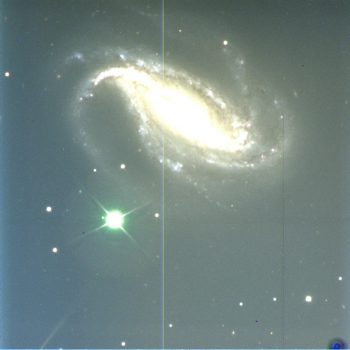 |
Colour composite RGB images of NGC 488 (left, 3*200 sec) and NGC 613 (right, 3*200 sec) as observed with the 4Kx4K CCD Imager mounted at the axial port of the 3.6m DOT. Several low-surface brightness objects (see Figure 3) along with deep photometry of point sources were performed during the testing phase of the camera during early 2017. The CCD Imager was used to calibrate some of the Landolt standard fields (PG and SA standards) along with known open cluster fields in various filters. For the assumed values of extinction coefficients published for the Devasthal site, multi-band photometry of the observed Landolt standard fields were used to derive the transformation coefficients. Once applied to the observed science frame of an open cluster field NGC 4147 (Figure 4), several point sources in B-band with a brightness of fainter than 24 mag with an accuracy of < 0.1 mag were detected in an effective exposure time of 2x600sec. These observations were performed during a dark/gray night and during average seeking conditions of around 1.6 arc-sec.
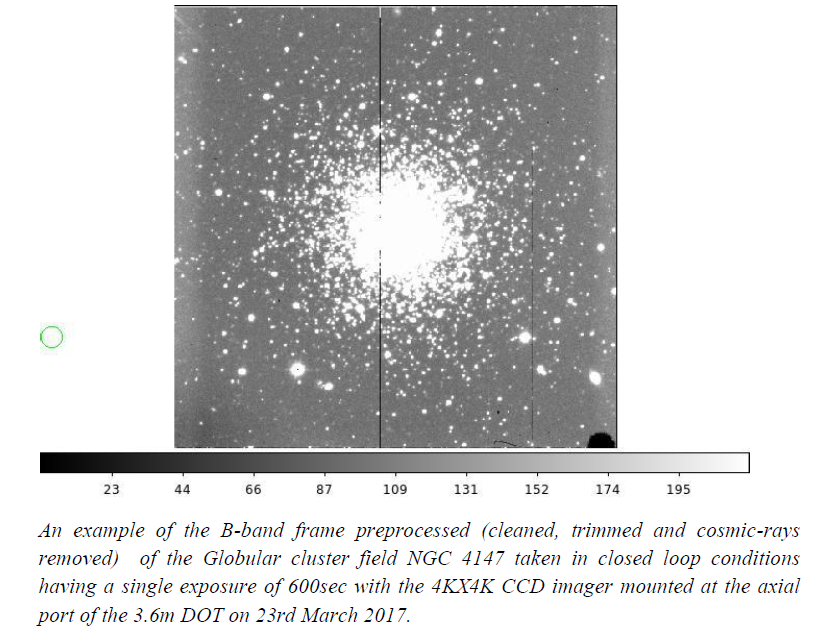
An example demonstrating capability of the 4Kx4K CCD imager getting deeper image for photometry of point sources in a Globular cluster NGC 4147.
The pre-processing of the images were done using the bias and flat frames observed in respective filters were used to pre-process the images using standard IRAF routine called ”ccdproc” after trimming the images to remove the over-scan area. We used ”cosmicrays” routine to remove the cosmic hits in various exposures and images were stacked wherever required.
After the pre-processing is done, we used the DAOPHOT-II FORTRAN subroutines in sequential standard orders (ie. Daogrow, ndaomatch, ndaomster, nccdstd, nccdlib, nfinal…etc) to calculate the transformation coefficients determined using the observed Landolt standard fields. These transformations were then applied to the observed globular cluster field NGC 4147 to calibrate the field. The results obtained through this procedure are described below in Figure 5 as color-magnitude diagram (CMD) of the NGC 4147.
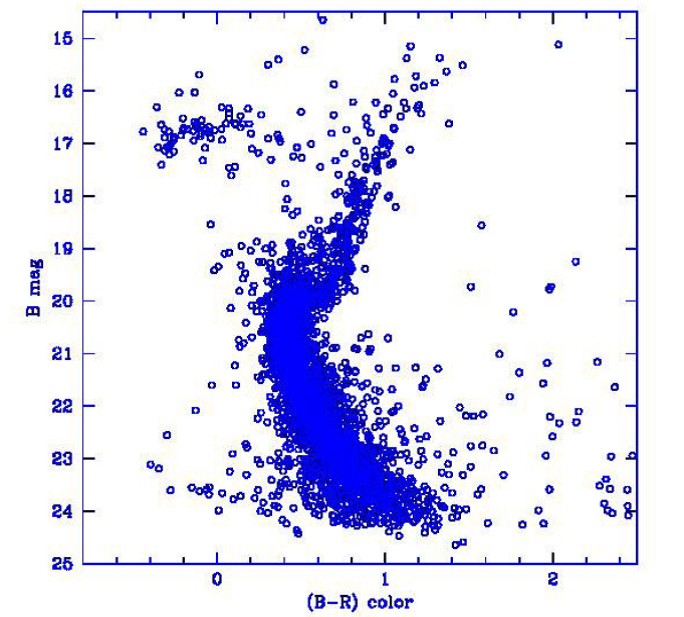
The color-magnitude diagram (CMD) of the Globular cluster NGC 4147 as obtained using the present calibration data taken using the 4KX4K CCD mounted at the axial port of the 3.6m DOT. The total number of common stars plotted (detected in both the filters) are around 3500 with a photometric accuracy of < 0.2 mag. The number of stars having B < 24 mag are around 150. There are many more detections for which error could not be established using the present data set. The scattering in the CMD could be due to membership issue which has not been accounted for at this stage of calibration. The main branch and other features typical for this cluster are clearly identified using our data set observed in B and R filters. If we go deeper in good seeing conditions, even fainter point sources could be detected with an improved photometric accuracy
Longer monitoring of the same cluster field also produced lightcurves of several variable stars as expected in the main sequence and horizontal branch of the colour magnitude diagram.
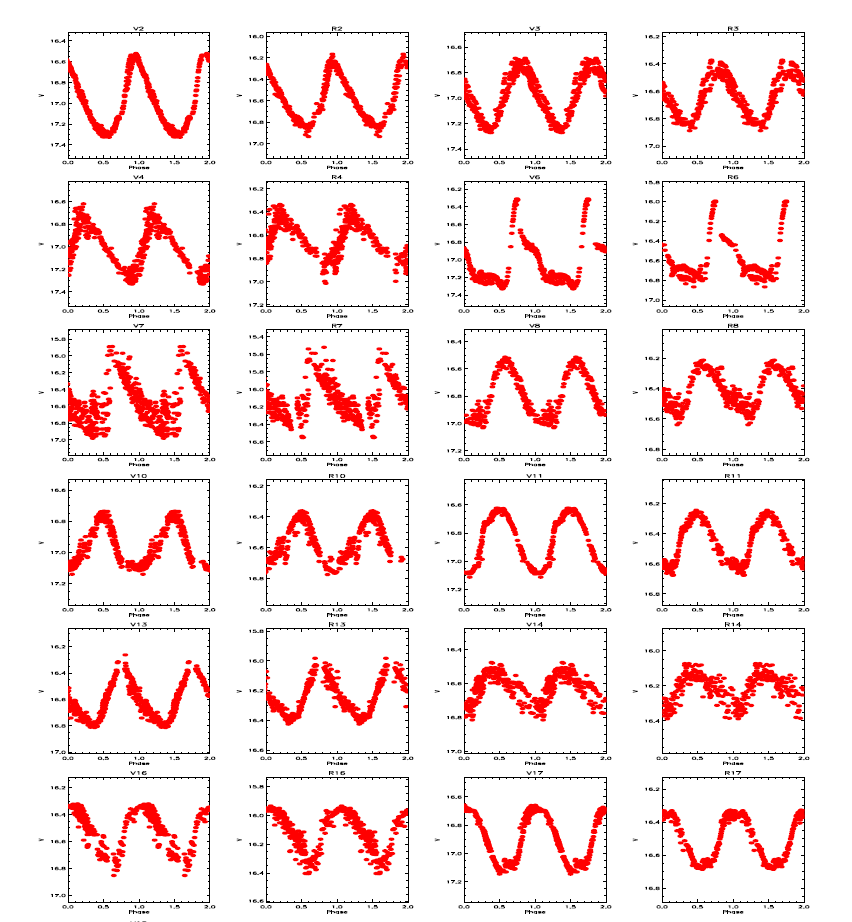
Examples of lightcurves of several variable stars as observed in the field of the Globular cluster field NGC 4147. The lightcurves have a range of periodicities and brightness as expected in case of such older clusters. The data and calibration results presented in this report will be published soon.
Another example, showing the capability of the imager demonstrating to observe features of low surface brightness are shown in below figure
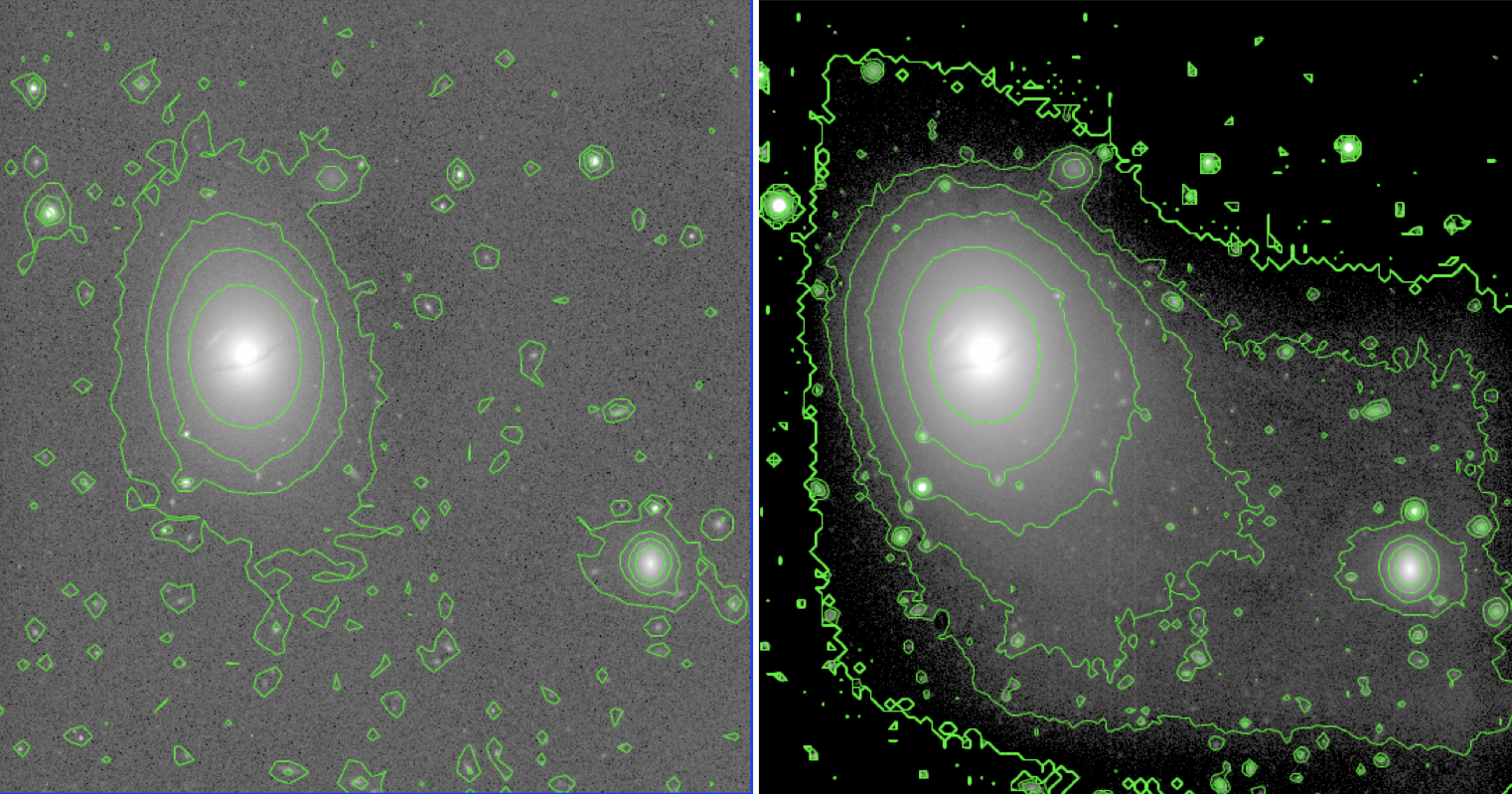
One of the nearby galaxy NGC 5486 along with neighbouring galaxy NGC 5487 (right panel) is compared with the similar field as observed by the SDSS survey (left panel). The figure shown in right panel is an equivalent exposure time of 5600 sec taken in r-band using the 4Kx4K CCD camera mounted at the axial port of the 3.6m DOT under a joint Belgian-Indian proposal accepted during the last cycle. It is clear that in the 3.6m DOT image (right panel), we are able to show the low-surface brightness features very clearly. The contour levels are 22, 23, 24, 25 and 26 mag/arcsec2. The interaction features between the two galaxies are clearly seen as an extended low-surface brightness feature between the two galaxies. The detailed analysis of the data is ongoing.
In this report, we present status of the 4Kx4K CCD imager used during first cycle of observations. As described, one could go deeper during best seeing conditions in rather longer exposures. During first cycle of observations many other objects like AGNs, Supernovae, White dwarfs, galaxies etc have also been observed under various proposals. We are yet to know about those results observed under various proposals. Noticed issues related to the CCD Imager like filter wheel slippage, light leakage, CCD temperature sensor related problems are expected to be resolved during the next cycle of observing with help of an improved version of the Imager.

